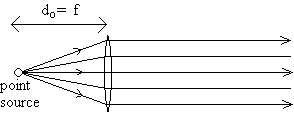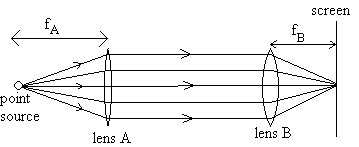
In this experiment, you will study converging lenses and the lens equation. You will make several measurements of the focal length of lenses and you will construct a simple astronomical telescope.
When a bundle of parallel light rays enters a converging lens, the rays are focused at a point in space a distance f, the focal length, from the lens. A converging lens is convex in shape, that is, thick in the middle and thin at the edges. A diverging lens is concave in shape, i.e. thin in the middle and thicker near the edges.

A converging lens can be used to form an image on a screen of an object. The lens equation relates the focal length f of a lens, the object distance do and the image distance di ,

In the diagram above, the points labeled F are the focal points of the
lens. The lateral magnification m of the image is defined as  .
From the diagram above, one can show that m can also be written as
.
From the diagram above, one can show that m can also be written as  .
.
In this lab, you will use three different techniques to measure focal lengths.
Method I: Use the lens to form an image of an object, measure the distances di and do, and then use eq'n (1) to compute f.
Method II: Place a point source of light at the focal point of a converging lens to produce a collimated (parallel) beam of light, as shown below. When the location of the point source is adjusted so that the beam coming from the lens is perfectly parallel, then the distance from lens to source is the focal length.

Equation (1) can be applied to this situation. The point source is the
object and the object distance do is the focal length f. With
do = f, equation (1) predicts that ![]() .
The rays from the lens converge "at infinity".
.
The rays from the lens converge "at infinity".

Method III: Once a point source and a lens has been set up to produce
a collimated beam, as shown above, then the focal length of another lens
can be easily measured. Place the new lens (lens B) in the collimated beam
and see where the rays are brought to focus. The distance from lens B to
the focal point is fB, the focal length of lens B.
In the last part of this lab, you will construct a simple astronomical
telescope. The astronomical telescope consists of two lenses: an objective
lens with a long focal length fo, and an eyepiece lens
with a short focal length fe . The objective lens forms an image
of a distant object (an object "at infinity"). By the lens equation, if
the object distance is ![]() ,
then the image distance is
,
then the image distance is ![]() .
This image, which appears a distance fo behind the objective
lens, is called an intermediate image, because it is intermediate between
the objective and eyepiece lens. The observer views this image through
the eyepiece lens which acts as a magnifying glass.
.
This image, which appears a distance fo behind the objective
lens, is called an intermediate image, because it is intermediate between
the objective and eyepiece lens. The observer views this image through
the eyepiece lens which acts as a magnifying glass.
The angular magnification M of the telescope is defined as the
ratio ![]() ,
where (as shown in the diagram below) q'
is the angular size of the image as viewed by the observer through the
telescope and q is the angular size of the distant
object as viewed without the telescope.
,
where (as shown in the diagram below) q'
is the angular size of the image as viewed by the observer through the
telescope and q is the angular size of the distant
object as viewed without the telescope.

Notice that the distance between the two lenses is ![]() .
From the diagram above, one can show that the angular magnification can
also be written as
.
From the diagram above, one can show that the angular magnification can
also be written as ![]() ,
the ratio of the focal lengths of the objective and eyepiece lenses.
,
the ratio of the focal lengths of the objective and eyepiece lenses.
Procedure
In this lab, you will use an optics bench, which is simply a rail, on which lenses are placed, with a ruler on the side for measuring distances. The other equipment includes a bright light source, which acts nearly like a point source, and three converging lenses labeled A, B, and C. There is frosted glass screen, labeled "I", on which you can view images. Finally, there is a metal plate with an aperture (a hole) in the shape of an arrow. The hole is covered with a frosted, translucent material (scotch tape). When this aperture is placed in front of the light source, it forms a convenient object for image-forming experiments.
Part I Images and Magnification.
In this part, you will use Method I to measure the focal length of lenses B and A.
(1) Place the light source at the end of the optics bench and attach it with the thumbscrew in the slot. Place the arrow aperture on the front of the light source; there is a magnet to hold it in place. It will save a little trouble in your calculations if you position the source so that the object (the frosted arrow) is exactly beside an integer mark (e.g. 2.0 cm) on the scale of the bench. Gently tighten the thumbscrew to secure the source, and record the position of the object. Connect the light source to the power supply and momentarily depress the "start" switch to turn on the light.
Place the frosted screen, I, at the far end of the bench and note its position, as indicated by the ring inscribed on the housing. Again, it will save some trouble if you locate it a convenient integer mark, like 90.0 cm or 92.0 cm.
Now put lens B on the bench close to the light source and move it slowly away from the source until you see a clear image on the screen. The image is most easily seen looking through the screen towards the light source, but it can also be seen from the other side. Adjust the position of the lens to give the sharpest image and record the position of the lens (as indicated by the ring on the housing). Calculate do, di, and from equation (1), the focal length fB.
(2) If the image is not centered on the screen, adjust the position
of the object plate on the front of the light source until the image is
centered. Now measure ho and hi, the heights of the
object and image. Compute the lateral magnification  and compare with the expected value
and compare with the expected value ![]() .
.
(3) Move the lens B to the screen end of the bench and then slide it away from the screen until you get a sharp image on the screen. Repeat the measurements above for do, di, ho, and hi. Recompute fB and m. Compare your measurements in parts (2) and (3).
(4) Measure the focal length fA of lens A using method I
(don't bother with the magnification m).
II. Use of a collimated beam
(1) Here you will use method II to measure the focal length of lens A. Remove the frosted arrow plate from the light source. The source itself is very small and can be considered to be a point source. Readjust its position so that the source is at a convenient integer mark on your bench. Now place lens A close to the source and slide it away until it produces a parallel, collimated beam. A good way to check that it is parallel is this: Point the beam at a nearby wall where it will produce a disc of light. Adjust the position of lens A until the diameter of the disc is exactly that of the lens opening. Now measure the distance from the point source to the lens; this is the focal length fA. Compare your measurement of fA with your previous value. Compute a final best value.
Now you will use method III to measure the focal lengths of lenses B and C.
(2) Without moving lens A, place lens B just beyond A, at a convenient integer mark, and put the frosted screen beyond B. Now move the screen until you jet a sharp image of the point source on the screen. The distance from lens B to the screen is fB.
(3) Repeat step (2) with lens C in place of lens B.
III. The astronomical telescope.
Choose the lens with the longest focal length. This will be the objective
lens with focal length fo . Also choose the lens with the shortest
focal length. This will be the eyepiece with focal length fe.
Place the eyepiece at one end of the optics rail and place the objective
lens a distance ![]() from the eyepiece.
from the eyepiece.
Aim the telescope towards the far end of the room, where there is an arrow and a graduated scale mounted on the wall, and adjust the telescope position until you can see the arrow through the telescope. It may be difficult to find the image since your telescope has a narrow field of view. Also, you may need to adjust the position of the eyepiece lens to get a sharp image. Is the final image you are looking at upright or inverted? Real or virtual? Explain your answers with words and diagrams.
Once you have found a clear image looking through the telescope, open
your other eye so that you can look simultaneously at the enlarged image
with one eye and the unenlarged image with the other eye. If you position
the telescope just right, you can see the two scales side by side and hence
estimate the angular magnification M of your telescope. Compare your answer
with the theoretical value of M .
Pre-Lab Questions (due at the beginning of lab).
 .
.